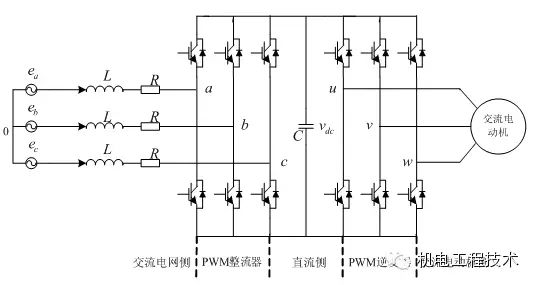Abstract: Aiming at the current situation of the electronic control system of medium and small power AC mine hoists, a dual PWM frequency conversion speed regulation system based on DSP is proposed. This article elaborates on the hardware and software design of the system in detail, designing the main hardware circuits and part of the core software flowcharts. Finally, a simulation study of the PWM rectifier and inverter is conducted, and the results prove the effectiveness of this solution.
Keywords: AC hoist; dual PWM; PWM rectifier; SVPWM; DSP
0 Introduction
Currently, about 70% of the medium and small power mine hoists used in China’s mines employ asynchronous motors with rotor series resistance speed control for AC drive. In the operation of the hoist, a large amount of electrical energy is consumed on the rotor’s additional resistance, resulting in poor economic efficiency of the system and causing serious energy waste.
How can we achieve energy conservation and efficiency improvement during the operation of the hoist? Frequency conversion speed regulation technology is a way to improve the control performance of the hoist’s electronic control system. Currently, most electronic control systems for hoists use voltage-type AC variable frequency drives, where the rectification part is uncontrollable, and energy cannot be transmitted bidirectionally. When the lifting motor is running at a reduced speed or crawling, the motor is in a regenerative braking state, and the regenerated electrical energy will be delivered to the DC side filter capacitor through the anti-parallel diode of the inverter circuit, thereby generating a pump-up voltage. Excessively high pump-up voltage may damage low-voltage devices like IGBTs, filter capacitors, and even break down the motor insulation, threatening the safety of the electronic control system.
The dual PWM frequency conversion speed regulation system scheme based on DSP proposed in this article can effectively solve the energy feedback problem of the lifting motor in a generating state. This article designs the main hardware circuits and core software flowcharts of the dual PWM frequency conversion speed regulation system, and through simulation experiments, it verifies that the PWM rectifier has advantages such as fast dynamic response speed, high output DC voltage stability, and high power factor; the simulation study of the vector-controlled PWM inverter shows that the system has good starting performance, steady-state performance, and strong anti-interference ability.
1 Structure and Principle of Dual PWM Main Circuit
In the dual PWM frequency conversion speed regulation system, both the rectification part and the inversion part adopt PWM technology, which can realize the regenerative energy feedback from the lifting motor to the grid, achieving bidirectional energy flow between the power supply and the motor, and realizing the four-quadrant operation of the lifting motor[1]. This main circuit is very suitable for the control of hoists, allowing the hoist motor to achieve automatic operation during starting, acceleration, constant speed, deceleration, and crawling. Additionally, when the motor reverses during the discharge of the cage or bucket, it can realize the four-quadrant operation of the motor, achieving energy feedback to the grid and promoting energy conservation of the entire system. The topology of the dual PWM main circuit is shown in Figure 1.

5 Conclusion
In response to the current serious energy waste and high harmonic pollution issues in the electronic control systems of medium and small power mine hoists, this article proposes a dual PWM frequency conversion master control system based on DSP, designing the main hardware circuits and core software flowcharts of the system. Through MATLAB simulation software, it has been simulated and realized, verifying the feasibility and superiority of the PWM rectifier and PWM inverter composed of the SVPWM control method in forming the main circuit.
Author Profile: Bao Xiping, male, from Shandong Mengyin, graduate student, lecturer. Mainly engaged in teaching and research in the fields of motors, power electronics, and power transmission technology.